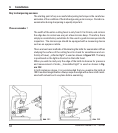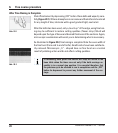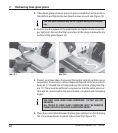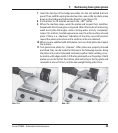
18
Instruction manual V2.1 – 04/2003
6. Fine coarse procedure
Coarse honing must be followed by fine honing using the Leica Fine Abra-
sive. As illustrated in Figure 10, the coarse honing action produces a single
facet. In proceeding with the fine honing operation, a second cutting facet
is ground on the knife at the cutting edge as shown in Figure 18.
The width of the fine facet is not of significance. This will vary from one knife
to the next. Also, this width often varies from one side of a particular knife to
the other; however, this fine facet should be approximately the same width
from one end of the knife to the other end. (See page 26 for comments on
typical sharpening problems.) While the above should be kept in mind, the
most critical factor in judging the success of fine honing is the degree to
which the small, remaining nicks are removed. Nothing exceeds this in im-
portance! Exactly how microscopically free of nicks the knife edge must be,
depends, of course, on the thickness of the tissue sections being cut. For
example, with a four-micron nick in the knife, you cannot obtain a satisfac-
tory section five microns thick because of a ,tearing” action. However, with a
ten-micron section, results may be acceptable although not uniformly even.
Your Leica Knife Sharpener . . .
is capable of producing an edge so near to perfection that subsequent hand
stropping will only result in „turning over” the edge. Do not strop!
Fig. 18
Either plate may be used for fine hon-
ing (either side), but be especially
careful to remove all coarse honing
abrasive and honing remnants from
the plate and knife. Washing both un-
der hot running water and using ordi-
nary detergent should suffice. Wipe
dry.


















